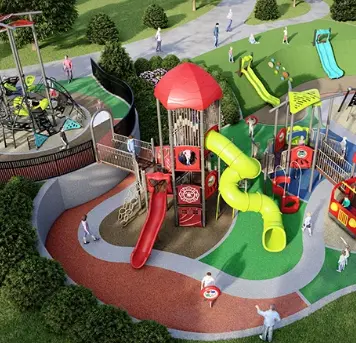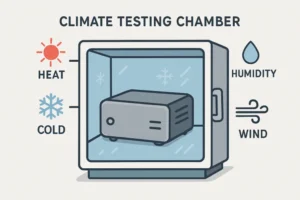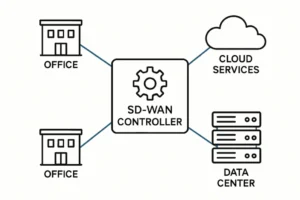Creating a children’s park is one of the most rewarding ways to foster fun, connection, and health in your community. From providing kids with a safe place to play and socialize to promoting physical activity and imaginative exploration, a well-designed park can enrich lives for years to come. However, constructing a children’s park involves careful planning, thoughtful design, and a clear focus on safety.
Planning and Design
Every successful children’s park starts with effective planning and a thoughtful design. Here’s how to approach this crucial first step.
Choosing the Right Location
The location you choose can make or break the success of your children’s park. Look for a site that is easily accessible, with good visibility from nearby roads or pathways. Proximity to residential areas, schools, or community centers is ideal for encouraging regular use. Additionally, ensure the site meets zoning and land-use regulations to avoid complications.
Size Considerations
The size of the park should align with the needs of your target audience. A small neighborhood park might need just a few play structures, while a larger community park can feature more diverse facilities like swings, slides, climbing walls, or exercise equipment for adults. Make sure to account for open spaces where children can run freely, as well as areas for seating and shade.
Designing a Safe and Engaging Layout
When designing the layout, aim for a balance between functionality, safety, and fun. Group similar activities together (e.g., a play zone for toddlers separate from high-energy equipment for older kids). Incorporate a mix of equipment that encourages physical activity, social interaction, and imaginative play. Obstacles like uneven terrain or hidden corners should be avoided to ensure visibility and reduce safety risks.
Selecting Equipment
The equipment you choose will be at the heart of your park, so it’s crucial to make informed decisions.
Evaluating Playground Equipment Options
Start by exploring a wide variety of playground equipment to suit different age groups and activity types. Consider climbers, swings, slides, balance beams, sensory play panels, and interactive equipment that stimulates creativity. Look into inclusive pieces like wheelchair-accessible swings or sensory play elements to ensure the park is welcoming for all childrens climbing frames.
Prioritizing Safety Standards
Ensure all equipment meets recognized safety standards, such as those established by ASTM. Choose materials that are durable, eco-friendly, and resistant to weathering or vandalism. Features like rounded edges, non-slip surfaces, and enclosed platforms contribute to a safer play environment.
Age-Appropriateness
Keep in mind that children of different ages have varying developmental needs and abilities. Include equipment designed for toddlers (ages 2–5) as well as older children (ages 6–12) to create an inclusive space.
Installation Process
Installing the playground requires careful execution to ensure everything is secure and safe for use.
Step-by-Step Installation Guide
- Ground Preparation:
Clear the area of debris, level the surface, and establish proper drainage to prevent standing water.
- Mark and Secure Boundaries:
Outline the play zones and install fencing, if needed, to contain the area and enhance safety.
- Equipment Assembly:
Work with professional playground companies, like those in Montana, to assemble and install equipment. Always follow manufacturer guidelines for proper installation and anchoring.
- Safety Surface Installation:
Add impact-absorbing materials such as rubber mulch, engineered wood fibers, or poured rubber surfaces to cushion falls and prevent injuries.
Safety Considerations
Safety should be a top priority throughout both the construction and maintenance phases.
Addressing Fall Heights and Impact Absorption
Falls are the leading cause of playground injuries, so it’s essential to minimize their risks. Use soft, impact-absorbing materials under all play equipment to reduce the likelihood of serious injury. Ensure that adequate safety zones surround each piece of equipment based on its fall height.
Regular Maintenance Checks
Inspect the park regularly to ensure everything remains safe and functional. Check for loose bolts, worn-out surfaces, or damaged equipment, and make any necessary repairs promptly.
Budget and Funding
Creating a children’s park can be a significant investment, but careful planning can help you manage costs effectively.
Creating a Realistic Budget
Outline all potential expenses, including site preparation, equipment purchase, installation, landscaping, and ongoing maintenance. Include a buffer for unexpected costs.
Exploring Fundraising Opportunities
Secure funding by applying for grants, hosting fundraising events, or reaching out to local businesses for sponsorships. Crowdfunding platforms are also a great way to gain community support while raising funds.
Cost-Saving Strategies
Look for discounts or secondhand equipment from trusted suppliers. Additionally, local businesses or volunteers may be willing to offer in-kind donations of materials or labor.
Community Involvement
A sense of community ownership and pride can transform a park into a cherished local space.
Engaging Local Volunteers
Invite community members to help with certain aspects of construction, such as planting trees or painting fences. Their involvement fosters a sense of connection and investment in the park.
Seeking Donations
Request donations of money, materials, or services from local businesses, civic organizations, and charitable groups.
Building Community Ownership
Host a grand-opening event to celebrate the new park with the community. Offer activities like a ribbon-cutting ceremony or a barbecue to encourage families to gather and enjoy the space.
Maintenance and Upkeep
To ensure the park continues to serve the community effectively, establish a clear plan for long-term maintenance.
Establishing a Maintenance Schedule
Develop a routine maintenance plan that includes weekly safety checks, seasonal landscaping, and annual assessments of equipment wear and tear.
Inspecting Equipment Regularly
Continually inspect play equipment for signs of rust, damage, or loosening. Replace or repair faulty parts immediately to prevent accidents.
Planning for Future Upgrades
Make provisions for future additions or renovations as the community’s needs evolve. Freshen up the park every few years with new equipment or landscaping features to keep it engaging.
Conclusion
Building a children’s park is more than a project—it’s a way to build community, encourage play, and spread joy. Follow these tips to make your park safe, functional, and loved for years. Ready to start? Work with professionals or local organizations to bring your vision to life. Now’s the perfect time to create a space for laughter, learning, and adventure!
Also Read-Designing a Home for a Large Family








